Adobe Commerce Vs Commercetools – Which Is Better?

Are you looking for the most powerful and reliable eCommerce platform that can cater to your B2B & B2C business needs? Then surely, two platforms that stand out are Adobe Commerce and Commercetools as they offer unique functionalities and are capable of catering to expanding business needs.
However, finding the right eCommerce platform will depend on your business needs and goals.
Adobe Commerce is an advanced eCommerce platform that is specially designed for large businesses to provide a personalized experience to B2B and B2C customers. On the other hand, Commercetools is a cloud-based eCommerce platform that is more flexible and helps large businesses build custom online stores with a headless approach.
Still, if you’re unsure and stuck at choosing between these two, this article will help you the best.
In this guide, we will have a detailed discussion on multiple areas, including:
- Key difference
- Pros and Cons
- FAQs
There is much more to cover about both platforms so that you can understand and make informative decisions.
But first, let’s start with a basic understanding of both platforms.
Adobe Commerce Vs Commercetools — Platforms at a Glance
Let’s understand both platforms separately to get a basic understanding:
Understanding Adobe Commerce

Adobe Commerce (previously known as Magento Commerce) is a highly advanced eCommerce platform that helps you build and manage an online store. In 2018, Adobe acquired Magento at $1.68 billion and rebranded it as Adobe Commerce (or Magento Commerce).
It’s become a most robust solution for large enterprises who have complex eCommerce needs and are looking for an extraordinary solution to build and manage their online stores and make feature-rich enhancements.
The platform allows on-premises and also offers a cloud-based hosting solution (known as Adobe Commerce Cloud), helping store owners decide based on their business needs.
If we glide into details and compare the platform to Magento, Adobe Commerce is an omnichannel solution for B2C and B2B merchants looking for enterprise-level support.
Some of the advanced capabilities of the platform include better order management, built-in marketing tools, B2B/B2C functionalities, multi-store management, endless customizations, third-party integration, a business intelligence dashboard, and much more.
On top of that, the platform offers strong 24/7 customer support to help their customers resolve technical queries.
Overall, Adobe Commerce is a one-stop solution for large enterprises that have complex commerce requirements. It can build, run, and grow multi-stores with complete flexibility and customization options and excellent support with B2B and B2C functionalities.
Understanding Commercetools
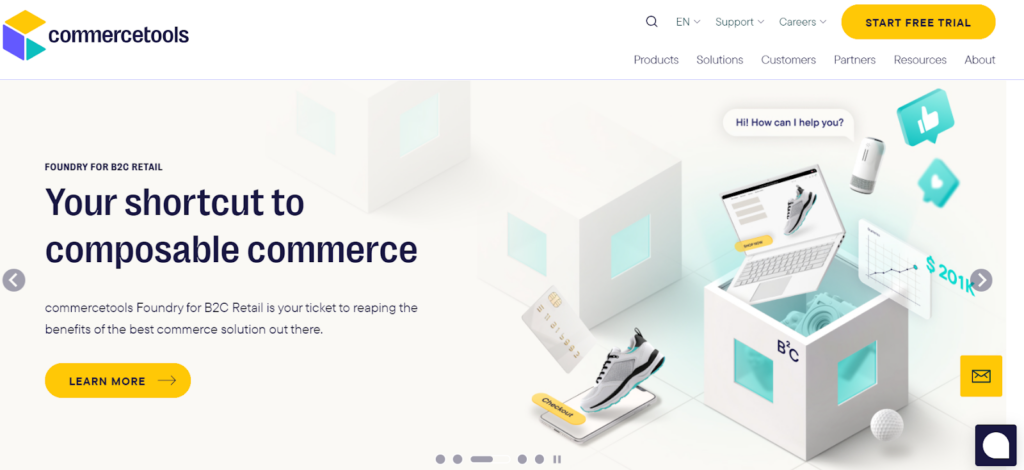
Commercetools is a cloud-based headless eCommerce platform that helps large businesses build and run outstanding shopping experiences across all channels.
Launched in 2006, this eCommerce platform offers a wealth of powerful features, including a fully API-enabled platform, cloud-based solution, B2B & B2C functionalities, inventory management, international shipping, and much more.
Commercetools is built on modern MACH principles (Microservice-based, API-first, Cloud-native, and Headless). When it comes to offering flexibility and personalized experiences, it has unparalleled capabilities to offer.
The platform can work best for any business size due to its flexible nature.
However, Commercetools has a steep learning curve for non-technical users, requiring a team of technical experts to manage it efficiently.
Overall, Commercetools stands out as a top-notch solution in the eCommerce industry. It is capable of fulfilling current business needs as well as the future of commerce.
;
Now that we know some basics about both platforms, let’s jump for a detailed comparison between them to identify which one is best for your business.
Adobe Commerce Vs Commercetools — The Main Difference
The main difference between Adobe Commerce and Commercetools lies in their architecture, flexibility, and approach to eCommerce.
Adobe Commerce offers a comprehensive, feature-rich platform with robust out-of-the-box functionalities. Commercetools, on the other hand, is built on a headless architecture, allowing businesses to decouple the front end from the back end.
Let’s compare both of these platforms for the following parameters:
- Architecture and Flexibility
- Ease of use
- Feature Set
- Customization Capabilities
- Security
- Pricing
- Support
- Scalability
Now, it’s time to discuss these parameters in detail to understand what your journey will look like if you choose to grow with either option.
1. Architecture and Flexibility
When it comes to comparing Adobe Commerce and Commercetools, the very first difference you’ll see is their architecture.
- Adobe Commerce → Monolithic
- Commercetools → Headless
In a monolithic architecture, all components of the APIs and data in your website are tightly coupled and deployed as a single unit. Meaning, the entire website is a single and large codebase. This architecture makes the customization process less flexible and can create performance issues, especially when business expands.
On the other hand, headless architecture comes with a detached front-end and back-end that are connected through APIs. The detached environment for data and design helps build a flexible website that is scalable, adaptive, and high-performing.
Adobe Commerce has a monolithic architecture, which means it combines both design and functionality in one platform. So, when you use its built-in CMS, the front-end and back-end work together as one system.
Plus, it supports headless architecture, which means the front-end and back-end are separable if required.
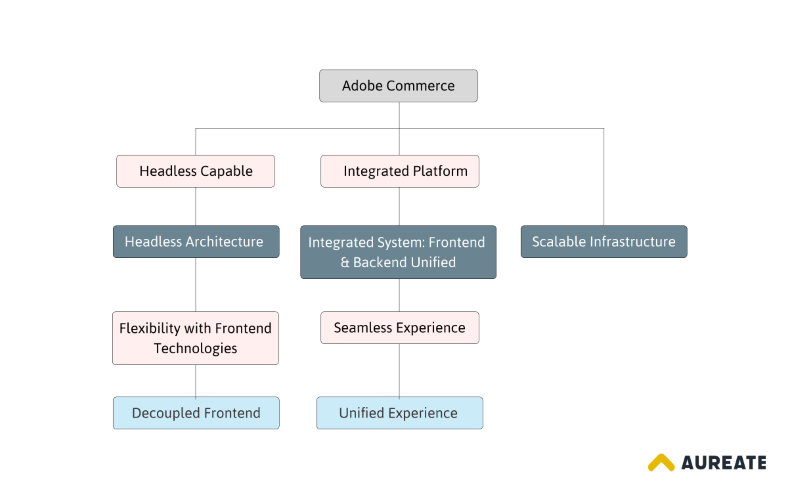
Adobe Commerce is a cloud-based platform that allows businesses to easily scale as per their business needs. It’s a robust, flexible, and scalable option for large enterprises.
Commercetools has a headless architecture, which means customization happening on the front end will not affect the back end. That’s why it offers more flexibility, high performance, and scalability for businesses.
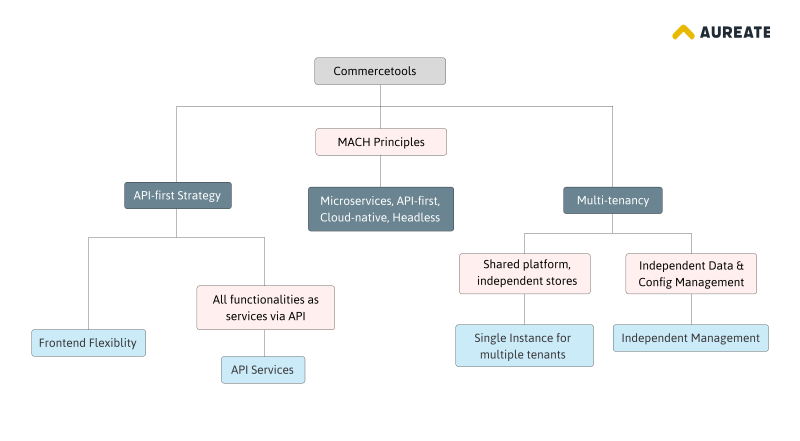
Its modern architecture follows the MACH (Microservices, API-first, Cloud-native, and Headless) principles, which makes this platform highly adaptable as per business needs.
Overall, Adobe Commerce is a powerful tool for large enterprises because it supports both monolithic and headless architecture as per business needs. On the other hand, Commercetools gives flexibility and high performance for those businesses that want to scale with its headless architecture.
2. Ease of use
Next up, you may have concerns about technicality and need a platform that is easy to use.
Honestly, both of the platforms require a technical edge for building and maintaining online stores. However, Adobe Commerce has a comparatively user-friendly interface, has drag-and-drop builder, and customizable templates, so yes, management will be easy once you get your grip on it.
Here’s a sneak peek at the Adobe Commerce dashboard:

On the other hand, Commercetools is quite a complex platform that surely requires significant technical expertise to use it effectively. As it is an API-first platform with headless architecture, it does offer unmatchable customization options, however, can be complex for non-technical users to manage a store with it on an initial level.
Here’s a glimpse of the Commercetools dashboard.
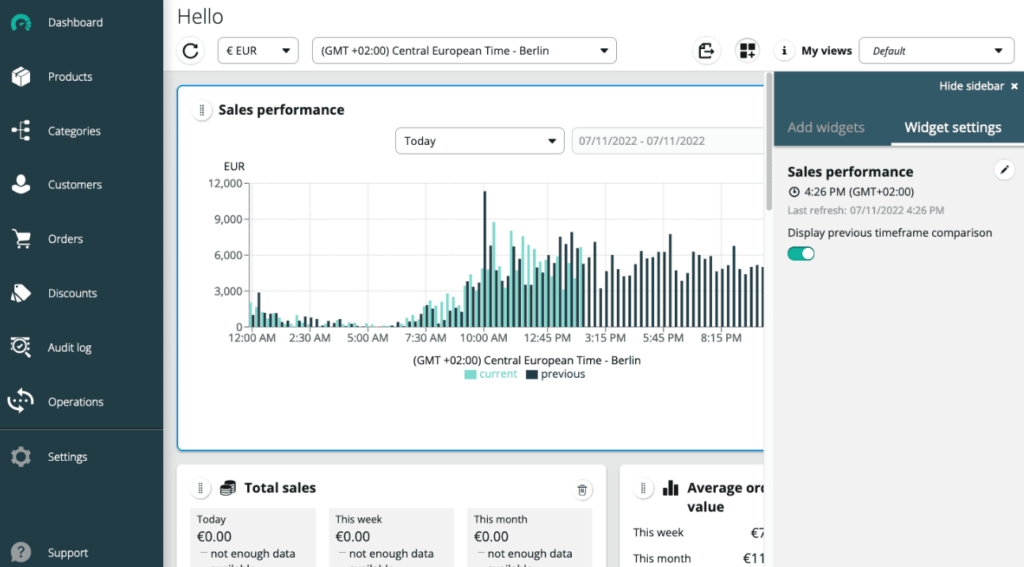
Once you know your work around the dashboard, you can easily manage your day-to-day operations with it. For store maintenance and the creation of additional functionalities, you’ll surely need to rely on the development team.
Overall, Adobe Commerce is easier to use for day-to-day store management. However, Commercetools requires technical expertise to do in-depth customization and has a steeper learning curve.
3. Feature Set
Every business chooses a platform that has all the required features to meet their needs.
So, researching both platform’s built-in features can help you find the best fit platform for your business.
To make this decision easier, let’s explore both platform’s out-of-the-box features and determine which platform best aligns with your business needs.
| Built-in Features of Both Platforms | |
| Adobe Commerce | Commercetools |
| Live Search | Cloud-native architecture |
| Customer Segmentation and Personalization | API-First Approach |
| B2B Functionality | Multi-Channel Support |
| Page Builder and Content Staging | Multi-Store Management |
| Multi-Source Inventory (MSI) | Analytics And Reporting |
| Progressive Web Application (PWA) Studio | B2B Functionality |
| Related Product Recommendations | Versionless platform |
| Headless Commerce | Tax calculations |
| Customer Account Management | Easy-to-use integration framework |
| Mobile Commerce | De-Coupled Front & Back Ends |
| Multiple Payment Processing Feasibility | Enterprise-grade security |
| 24×7 Tech Support With Dedicated Account Manager | International shipping |
It seems that both Adobe Commerce vs Commercetools have the capabilities and advanced features.
However, each platform comes with its own unique purpose. So, choosing the right platform between them will completely depend on your business needs. Let me guide you on it.
- If you’re a large enterprise looking for a highly customizable, feature-rich, and easy-to-use platform, then Adobe Commerce is a go-to choice.
- On the other hand, if you’re looking for a platform to manage complex operations of online stores and have a team of developers, then Commercetools allows you unparalleled customization to match your business needs.
4. Customization Capabilities
Customization is one of the key features that every business is looking for. Because it helps to build their unique brand identity and help businesses provide a personalized customer experience.
So, let’s find out which platform has better customization capabilities!
First of all, both platforms offer different levels of customization options.
Adobe Commerce is a right-fit platform for those businesses looking for moderate to greater levels of customization. It has various customization options including pre-built themes, drag-and-drop editor, extensions, and code modifications to make required changes in the storefronts.
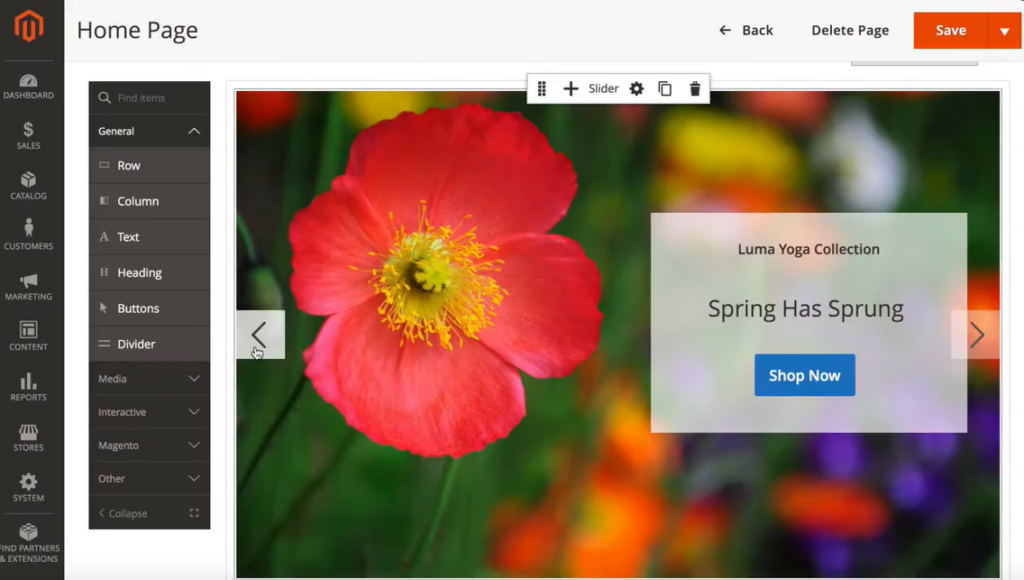
If you want to add basic customizations on your own, you’ll learn it over time.
However, Adobe Commerce requires technical expertise to integrate tools and extensions, especially when you seek extensive customization. This is because it involves work around coding.
On top of that, Adobe Commerce has an extensive marketplace with a wide range of extensions to add-on functionalities without any coding.
Commercetools has an API-first approach with headless architecture, which means customization can be done via API integrations.
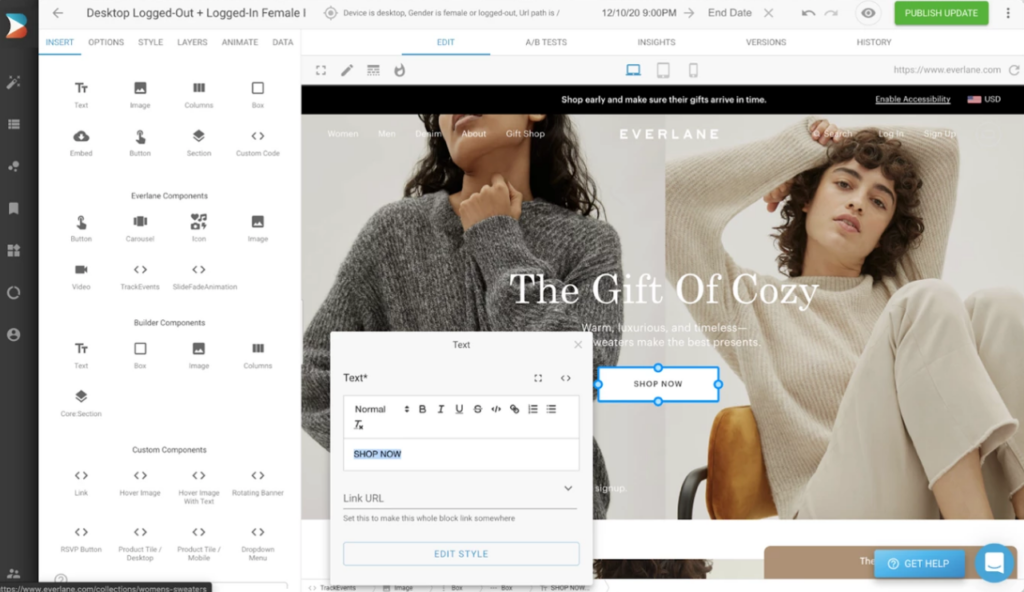
This approach allows high-level customization, but this level of customization can be done by developers with extensive knowledge of coding.
Overall, both of the platforms are highly customizable.
5. Security
Security is another big concern. Adobe Commerce and Commercetools both platforms are both highly secure and have various built-in security features. Let’s explore their way of prioritizing security.
Adobe Commerce, at first, frequently releases updates and patches to address vulnerabilities and protect security. Also, they hold various compliance certifications, including:
- PCI DSS
- GDPR
- ISO/IEC 27001
The platform comes with multiple other security features such as DDoS protection, Web Application Firewall (WAF), Recaptcha, and Two-Factor Authentication (2FA), which make this platform highly secure against any cyber threats.
Commercetools, on the other hand, is also compatible with security standards; including:
- ISO/IEC 27001
- PCI DSS
- GDPR
Apart from that, Commercetools is regular at releasing security updates to address emerging vulnerabilities. As Commercetools follow an API-first architecture, users are responsible for managing their own SSL/TLS implementation, which might require a developer.
In short, both platforms are secure enough to run a successful eCommerce store.
However, Adobe Commerce has an edge over Commercetools for security parameters with advanced protections, while Commercetools provides user-managed security configurations.
6. Pricing

Your budget plays a crucial factor in making the final decision while choosing the platform. So, let’s understand which platform comes under your budget and helps earn better ROI.
Starting with Adobe Commerce, they charge based on the business’s GMV (Gross Merchandise Value) and AOV (Average Order Value). Here’s an idea on cost.
- If your annual sales (Gross Merchandise Value) are under $1 million, then the platform subscription cost may fall around $22,000/year.
- If your sales increase by more than $25 million, then the cost can reach up to $125,000/year.
Plus, there are different pricing plans available in Adobe Commerce for businesses of different sizes and needs. Here’s the estimated Adobe Commerce pricing with additional costs to consider:
| Aspect | Adobe Commerce | Adobe Commerce Cloud |
| License Cost | $22,000 – $125,000/year | $40,000 – $190,000/year |
| Hosting | From $500/year (Will vary based on your chosen hosting solution) |
Included in this Plan |
| Development Cost | Starting from $7,000 | Starting from $7,000 |
| Maintenance | $70 – $140+/hour | $70 – $140+/hour |
| SSL Certificate | $50 – 300/year (Depending on your chosen type and provider) |
$50 – 300/year (Depending on your chosen type and provider) |
| Payment Integration | 2.9%+ $0.30 Per transaction (charged by chosen payment gateways) |
2.9%+ $0.30 Per transaction (charged by chosen payment gateways) |
That was a basic idea on the cost of developing an eCommerce store with Adobe Commerce.
Commercetools, on the other hand, has not publicly announced about their pricing model, however, it falls on the budget-friendly side when compared with Adobe Commerce.
To get started with Commercetools, you’ll need to request custom quotations from their team.
Overall, the winner will depend on your budget and business requirements. If you’re looking for an affordable option then Commercetools has some budget-friendly options or if the budget isn’t an issue with you, Adobe Commerce is also great for scaling your business.
7. Support
It’s obvious that not everyone has the technical expertise to resolve the issues. So, you’ll need a platform that provides greater customer support.
Let’s find out which platform is offering better support.
Adobe Commerce, at first, provides dedicated support to only those customers working with their Adobe Commerce Cloud plan, which comes with hosting included. So, if you’re choosing to get ahead with their managed hosting solution, you get 24/7 support from their dedicated team members.
And if not, you can hire one of their team members to discuss your potential issues. Otherwise, Adobe Commerce also has a vast community of developers and merchants to help you along your journey.
On the other hand, Commercetools offers dedicated support for all of their customers via phone, email, and live chat.
In overall, for Adobe Commerce you might need to depend more on paid support options or community while Commercetools focuses on providing dedicated support via different channels.
8. Scalability
Every business has a single aim to scale globally.
So, it’s important to choose the right platform that allows their business to scale globally.
Let’s find out if Adobe Commerce or Commercetools has a better scope of scaling as your business expands. I’ve added a table for better understanding.
| Aspect | Adobe Commerce | Commercetools |
| Platform Architecture | It’s monolithic but supports headless setups | It’s headless and cloud-native with MACH principles |
| Traffic Handling | It’s built to work well with high traffic with scalable cloud | It’s built to work well with high traffic with scalable cloud |
| Product Volume Handling | It is designed for managing large catalogs efficiently | It can handle extensive catalogs flexibly |
| Performance | It depends on chosen hosting solution when choosing its on-premise solution | Consistently high due to its cloud-based architecture |
| Flexibility for Customization | Is highly flexible | Is highly flexible |
| Scalability Management | Will require experts | Will require experts |
Adobe Commerce is the perfect choice for large enterprises who are planning to scale their business. It has all the required features and capabilities that are required for scalability including handling high traffic, extensive product catalogs, complex operations, robust security and much more.
Commercetools, on the flip side, is an ideal choice for businesses that prioritize flexibility and scalability. With its cloud-native and headless architecture, it can easily handle high customization and effectively manage heavy traffic.
That’s all about their differences.
If you’re still confused on how they differ, i’ve added a quick comparison table in next section, Let’s jump.😀
Adobe Commerce Vs Commercetools — Table Comparison

Here’s a brief comparison of all aspects of Adobe Commerce and Commercetools for you to make a right choice between them.
| Aspect / Feature | Adobe Commerce | Commercetools |
| Architecture | Monolithic with headless support | Headless |
| Rating | 8.2/10 | 8/10 |
| Pricing Model | Annual, quote-based | Monthly, quote-based |
| Free Trial | Yes ✅ | Yes ✅ |
| Pricing | Starts from $40,000 | Starts from $2,000 |
| Best Suited for | Large-sized Businesses | Medium to Large-sized Businesses |
| Platforms Supported | Windows, Mac, Linux & Android | Windows, Mac, Linux, Android & Chromebook |
| Deployment Supported | Cloud & On-Premise | Cloud |
| Support | Knowledge Base | Email, Phone Chat, FAQ Forum, Knowledge Base & 24/7 Live Support |
| Training Resources | Documentation & Videos | Documentation, In-Person, Live Online Videos & Webinars |
Now, you know exactly the key difference between Adobe Commerce vs Commercetools. Let us help you make the final decisions about which platform is suitable for your business.
Finalizing eCommerce Platform for your Business!
Finally, we’re here to make our final decision between Adobe Commerce and Commercetools.
Yes, both of these platforms come with immersive capabilities and benefits. But the choice will completely depend on your business needs. So, here’s how you can find the right platform:
Choose Adobe Commerce If:
If you’re a medium to large enterprise looking for extensive features, personalized customer experience, and customization options for complex operations, then it’s worth considering this option.
Choose Commercetools If:
If you’re a large business that mainly focuses on scalability, then this platform is best because of its API-first approach and easy integration with other systems for add-on functionalities and business growth.
Whether it’s Adobe Commerce or Commercetools that you choose, make sure to evaluate your business’s specific requirements and needs before making a final decision.
Still in doubt?
Our experts at Aureate Labs are ready to help you find the right eCommerce platform for your business by personally understanding your business needs and goals.
Get a free consultation with our eCommerce experts today!
FAQS – Adobe Commerce Vs Commercetools
1. Is Adobe Commerce or Commercetools more popular?
Adobe Commerce has a larger market share and is widely adopted, especially among large enterprises. Commercetools is used by some major brands but has a comparatively lower user base.
2. What business size Adobe Commerce vs Commercetools are suited for?
Adobe Commerce is ideal for large enterprises. On the other hand, commercetools is suitable for medium-large size businesses.
3. What is the main difference between Adobe Commerce vs Commercetools?
Adobe Commerce has a monolithic architecture where design and functionalities are integrated but can be decoupled. Commercetools uses a headless approach with MACH (Microservices, API-first, Cloud-native, and Headless) architecture for better flexibility and scalability.
4. Is Adobe Commerce or Commercetools more scalable?
Commercetools is more scalable because of its MACH architecture, which allows independent scaling and modifications to features. Wheel Adobe Commerce also supports a headless approach but can be complex to scale and require technical expertise with additional resources.
5. Is Adobe Commerce or Commercetools more expensive?
Adobe Commerce has a lower upfront cost but can be more expensive than Commercetools as per the business requirements. On the other hand, commercetools requires a higher initial cost but potentially lower total cost of ownership (TCO) than Adobe Commerce in the long run with easy scalability.






Post a Comment
Got a question? Have a feedback? Please feel free to leave your ideas, opinions, and questions in the comments section of our post! ❤️